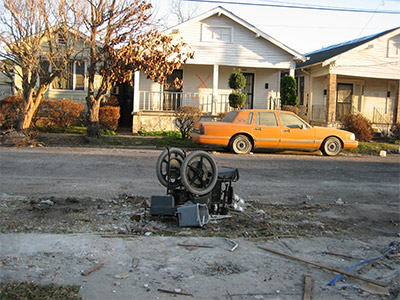
Ten years ago this week, the world watched in horror as Hurricane Katrina struck the Gulf Coast, leaving a trail of devastation and human suffering in its path. The storm’s powerful winds, storm surge, and flooding destroyed communities and infrastructure in Louisiana, Mississippi, and Alabama.
The storm inflicted a terrible toll, killing at least 1,330 and injuring thousands. Older adults and people with disabilities were among the hardest hit. According to a White House report, 71% of the people who died in the state of Louisiana during the storm were over the age of 60. And as the National Council on Disabilities (NCD) has noted, “people with disabilities, especially those living in poverty, were disproportionately left behind in Hurricane Katrina.”
Historically, community and organizational evacuation plans have not adequately accounted for the needs of older adults and people with disabilities. An NCD report (PDF) released a year after Hurricane Katrina found that many emergency communications were inaccessible to people with certain disabilities. The report also showed that many older adults and people with disabilities who did want to evacuate had no way of leaving the region. When buses were available, they often lacked wheelchair ramps or required a wait of many hours in temperatures of 90 degrees or more. And those who could evacuate were often turned away from emergency shelters because of their disabilities. For those of us here in the Northeast, Hurricane Sandy illuminated some similar issues.
Recently, the Rooted in Rights project of the AIDD-funded Disability Rights Washington released “The Right to be Rescued,” a short documentary capturing the experiences of people with disabilities during the storm and the devastating consequences of the lack of emergency planning for their needs. Watch the documentary online.
No one should be left out of emergency planning, or left behind during a disaster. In the aftermath of Hurricane Katrina, policymakers, emergency response professionals, and aging and disability advocates have worked together to identify and address many of the issues that led to such tragic consequences.
For example, FEMA developed recommendations (PDF) to assist emergency managers and shelter planners in understanding the requirements related to sheltering children and adults with functional support needs in general population shelters. And the National Council on Independent Living and the National Disability Rights Network (an AIDD grantee) are partnering with the FEMA and the American Red Cross to ensure that the needs of people with disabilities of all ages are incorporated into all aspects of planning for, responding to, and recovering from disasters.
We can all be a part of the effort to make emergency planning more inclusive and build on the progress that has been made over the last decade. And you do not have to work for FEMA or an Aging and Disability Resource Center to be a part of the solution. One of the most important things each of us can do is develop an emergency plan for ourselves and our families.
September is National Preparedness Month, an opportunity to take action to prepare for emergencies and disasters. The theme for this year’s observance is Don’t Wait. Communicate. Make Your Emergency Plan Today.
We each have unique needs and abilities that could affect how we respond during an emergency. By developing a plan today that takes your needs into account, you can increase the likelihood that you and your loved ones remain safe. FEMA's Ready.gov portal is making it easier to “prepare, plan, and stay informed for emergencies” with specific resources for older adults and people with disabilities.
Additional Resources for Inclusive Emergency Planning
Here are some tools to help caregivers, service providers, communities, and local officials include older adults and people with disabilities in emergency planning:
- ACL National Family Caregiver Support Program: Just in Case—Emergency Readiness for Older Adults and Caregivers (PDF)
- CMS Emergency Preparedness Checklist: Recommended Tool for Persons in LTC Facilities & Their Family Members, Friends, Personal Caregivers, Guardians & Long-Term Care Ombudsmen (PDF)
- FEMA Guide to Planning Personal Assistance Services in General Population Shelters (PDF)
- FEMA Guidance on Planning for Integration of Functional Needs Support Services in General Population Shelters (PDF)
- Northeast ADA Center Emergency Response and Disability for First Responders
- Independent Living Research Utilization: Emergency Preparedness On-Demand Training and Resources
- Rehabilitation Engineering Research Center: Emergency Communications
Find even more in Help & Resources.

